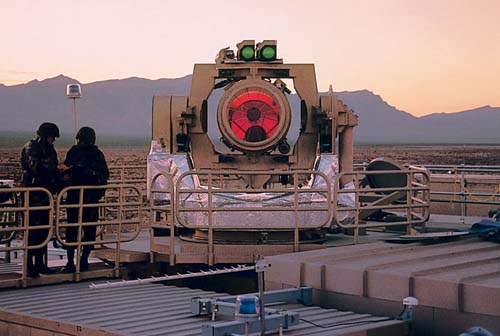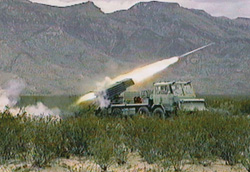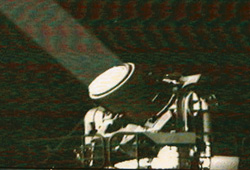Beyond Bullets

The Mobile Tactical High Energy Laser has scored 3Array kills, including 26 Katyusha rockets.
A fuzzy, green dot from a laser pointer drifts along the ground and comes to rest on an odd-looking piece of metal. For the next few seconds the light hangs motionless. Then, just as we realize the dot is focused on a hand grenade, the image on our viewing screen dissolves in white light. The really impressive sight comes into view when the screen clears. We see that the concrete pad beneath the blast is scorched, but otherwise perfectly intact. "We burn the least explosive part of the munition," explains Scott McPheeters, our guide for a visit to the Army's laser weapons testing center on the sprawling White Sands Missile Range in New Mexico. You may have observed the same low-force blast when as a kid you stupidly tried using a match to light a firecracker that had lost its fuse.
Over the next few minutes we watch the Army's Humvee-mounted Zeus laser cast its glowing eye upon an assortment of unexploded ordnance. Seeing Zeus in action, we realize we are looking at more than a fast new tool for safely clearing unexploded ordnance. We are looking at the first major military breakthrough of the 21st century.
Chemical Lasers
The military began exploring the combat potential of lasers in the 1960s. At that time, researchers focused almost exclusively on chemically activated lasers. Tests at the High Energy Laser Systems Test Facility (HELSTF) here at White Sands have produced impressive results ever since. As early as 1978, a chemical laser blasted through a tethered helicopter. "MIRACL is a very capable laser," says HELSTF director Tom Hodge, referring to the Mid-Infrared Advanced Chemical Laser, the workhorse of military laser research. "It is also roughly the size of the power and light plant down the road. It isn't a combat system. It is a testbed." Thus far, the most compact chemical laser to score a kill is the Mobile Tactical High Energy Laser (MTHEL), shown here. A few weeks before PM's visit to White Sands, MTHEL became the first laser weapon to track and destroy multiple artillery projectiles in flight at the missile range. The Air Force is using similar chemical laser technology for its Scud-killing airborne laser, which fits inside a modified Boeing 747-400 freighter ("Air Force Plans Fleet Of Laser Cannons," April 1997, page 16).

Katyusha rocket is shown being fired from a launcher as part of the Mobile Tactical High Energy Laser (MTHEL) testbed live fire test program.
Portable Power
Zeus makes a sharp break with the past. Instead of using highly reactive chemicals to create a laser beam inside a plume of hot gas, Zeus performs its magic inside a special type of glass. Its operating principle is the same as that of all solid-state lasers, including those in CD drives and DVD players. Basically, light from a beefed-up flashbulb sends a stream of photons into nine neodymium-doped glass discs. Inside the discs, the light, which can be thought of as a rabble of raw recruits, becomes organized into a crack drill team--what physicists call a beam of coherent, monochromatic light. Gaining strength as more light is pumped in, the colorless laser beam bursts out one side of the crystal with enough power to heat steel at 200 yards. Add a control system to keep the beam on target and a database that tells the beam which part of the munition to focus upon, and you have the perfect tool for safely defusing unexploded ordnance.

MTHEL testbed beam director during laser firing. In this infrared photo, the MTHEL testbed high-energy laser beam can be seen as it is projected by the beam director at a Katyusha rocket in flight.
Looking beyond ordnance removal, the Army envisions solid-state heat capacity (SSHC) lasers, such as that used in Zeus, as the ultimate defensive weapon. "Rockets, artillery and mortars cause half of the casualties," says Chip Hardy, SSHC laser project manager at HELSTF.
Senior military officials are more cautious in their assessment. "Our preference would be to walk away from chemicals," Brig. Gen. John Urias, the U.S. Army's point man on lasers, tells PM. He quickly points out that at their current stage of development, solid-state lasers are hardly troublefree. "If the laser overheats, the system shuts down."
Researchers at the Lawrence Livermore National Laboratory in Livermore, Calif., which developed the 10-kilowatt SSHC laser for the Zeus system, believe the power can be increased to the 100 kilowatts needed to blast enemy rockets from roughly 5 miles away.
The difficulty in creating a stronger pulse is not in producing a more powerful laser beam, but keeping the laser itself cool. A 100-kilowatt laser will require 1 megawatt of input power. The heat produced when the laser is fired has to be removed to prevent damage. Livermore scientists have solved the problem by developing a way to rapidly cool the laser between firings without losing its structural integrity or lasing characteristics. A lab spokesman says the research team is on target for delivering a demonstration version by 2007.



